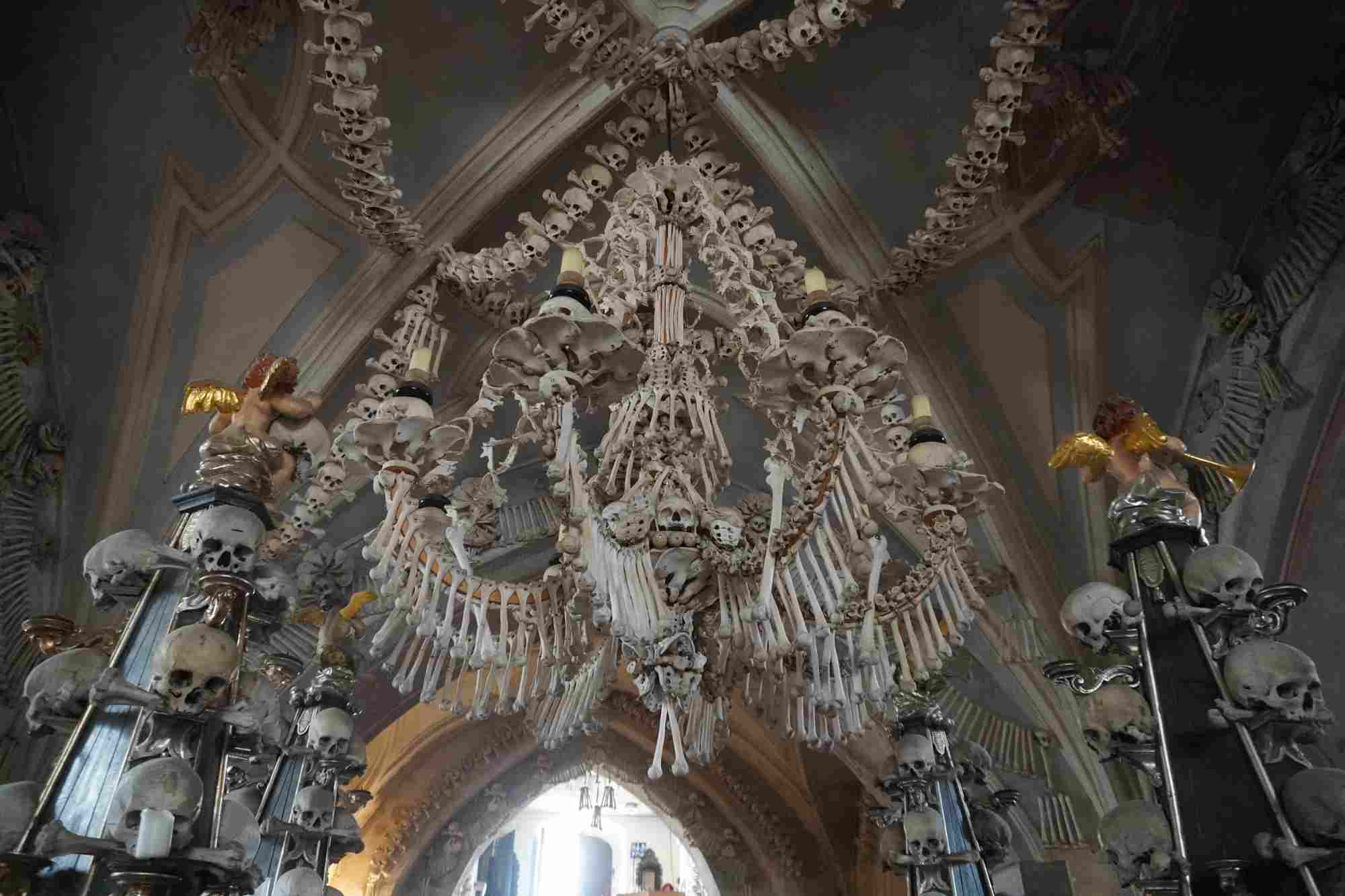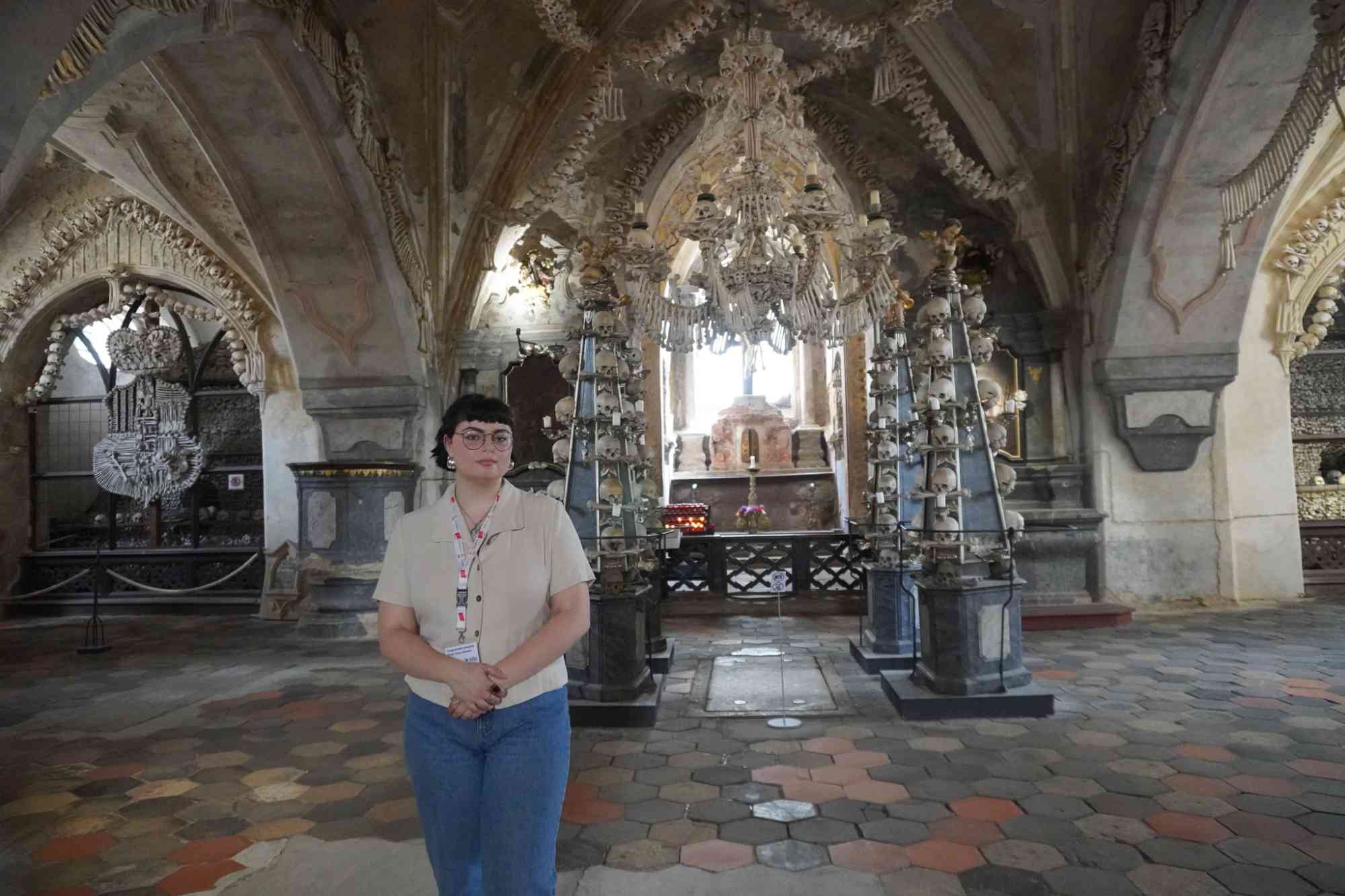A Rochester undergraduate ponders what it means to display and visit human remains.
In the Middle Ages, as the bubonic plague repeatedly ravaged Europe, killing up to a third of the population, the “Black Death” presented for many towns and municipalities a practical problem beyond the obvious suffering: what to do with all the bodies? Added to that came frequent wars and violent conflict—so much so that local cemeteries simply ran out of space.
One solution included digging up older graves and transferring the human remains—now decomposed and skeletonized—to so-called ossuaries or crypts located within preexisting religious spaces, such as churches or burial grounds.
“These mass death events in the Middle Ages really kick-started the need for bone storage locations,” says Julia Granato ’23, an undergraduate student double majoring in evolutionary biology and archaeology, technology, and historical structures at the University of Rochester. With the help of the University’s Discover Grant and the Meliora Scholars program, Granato, who is originally from Monroeville, New Jersey, crisscrossed Europe this past summer to study human bone collection and display sites in Prague, Vienna, Florence, and Rome.
Western examples of collecting and preserving skeletal remains date back to early Christian crypts in ancient Rome. Later in the Middle Ages, the Catholic Church began preserving as relics the mortal remains of its martyrs and saints, which pilgrims would come to visit—introducing a public element to the collections.
Sometimes the bones in ossuaries weren’t just stored but also displayed in eye-catching manners: artfully stacked, or strung like garlands across doorframes and arches, or fashioned into morbid candelabras. To a modern observer it might feel not unlike a permanent Halloween thrill, if you will, made of human bones and skulls.
Granato wondered: Is the display of human remains fundamentally ethical? In other words—is it ok to ogle death and the departed? Or is it merely a pandering to our base fascination with morbid thrills?
Of course, the answer depends on whom you’re asking—and when.
An adventure in independent, undergraduate research
Granato is now in the process of turning her thesis and independent research project on the ethics of displaying human remains into a book manuscript and a series of academic papers. She offers a history of the collection and treatment of human remains in the West, and a discussion of the recent phenomenon of “dark tourism”—the visiting of sites that commemorate or offer reminders of tragedy or death, such as cemeteries, ossuaries, crypts, or catacombs, as well as museums associated with death or violence, war memorials, and even haunted houses.
Mapping dark tourism destinations
As part of her research, Granato has created a virtual component—an interactive map of dark tourism sites in the western world.
Supervising Granato’s project is Elizabeth Colantoni, an associate professor of classics and an expert on ancient Roman archaeology and religion, who invited the student to join her at an Italian dig site this past summer. Colantoni says that Granato’s work “embodies the best of student research here at Rochester,” neatly combining her two majors.
“She has used her training in the humanities to make sense of her STEM studies, and her research on the ethics of the display of human remains in museums and at cultural sites has certainly influenced my own thoughts on the topic,” says Colantoni.
This month, Colantoni and Granato copresented a paper at the annual conference of the Archaeological Institute of America. Together they questioned the ethics of burial archaeology and suggested standards for archaeologists and institutions on how best to approach burials and human remains.
Granato gets her ideas from disparate places.
Among the things that got her thinking about the rights of the dead—and how to interact with the dead respectfully, either as a scholar or a layperson—was the Native American Graves Protection and Repatriation Act. The federal law, enacted in 1990, pushes for the return or repatriation of Native American cultural items from museums, federal agencies, or other institutions, including specifically human remains and related funerary objects.
Some of her questions also stem from the study of literature and media. Granato is a Take Five Scholar, taking advantage of an opportunity unique to the University of Rochester, where undergraduates can apply to spend a fifth, tuition-free year at the University to pursue a multidisciplinary program of courses addressing a topic or idea that is unrelated to their major course of study. Granato’s Take Five Program is an exploration of science fiction and fantasy in literature and media, and the ways they can both reflect and distort “our collective memory of historical events,” she says.
One of Granato’s Take Five classes—Medieval Otherworlds, taught by Rochester English professor Thomas Hahn, who is also her Take Five advisor‚ delves into medieval stories of the metaphysical, such as purgatory, heaven, spiritual journeys, or visitation. For her final paper Granato explored conceptualizations of medieval death.
She is an “exceptional scholar,” Hahn says, “one of a kind, both in her possession of multidisciplinary expertise, and in her lively ambition to put her diverse interests into unprecedented dialogue with one another.”
Visiting death, from Medieval Europe to modern times
Medieval Europeans certainly viewed ossuaries differently from many modern-day tourists.
According to Granato, people saw these ossuaries as memento mori—a constant reminder that life on Earth was short and death lurked just around the corner. The Capuchin Crypt in Rome, a stop on her summer tour, displays thousands of remains of Capuchin friars, arranged decoratively across several crypts, largely sorted by their anatomical function—a room for pelvises, another for skulls, a third for leg and thigh bones. At the entrance to this 17th-century decorative crypt, Granato came upon a plaque that reminds visitors “what you are now, we once were; what we are now, you shall be.”

Part of her thesis is a case study of the ossuary in Kutná Hora, a UNESCO world-heritage site in the Czech Republic, which at Kostnice Sedlec—or Ossuary Sedlec—holds one of the most famous human bone displays in the world.
What makes this experience so visceral? Maybe it’s “that wrongness, the uncanny,” the Rochester undergraduate thought as she toured the site. She met Australian tourists there who told her they liked horror movies and admitted to having come for the thrill. Others were trying surreptitiously to snap pictures, which the ossuary had begun prohibiting two years earlier. What surprised Granato was that for all the clear trappings of a successful tourist site, replete with gift shops hawking skull souvenir mugs, candles were still burning inside the ossuary, lit by visitors as a sign of remembrance.
“To me that was really profound, because going into this I didn’t really expect any sort of real spiritual experience from any visitors,” she says. “But to me, it was very important that it does still happen.”
There’s a theological argument in Medieval Christian religion, Granato points out, that bodies ought to be buried intact so that the dead could be resurrected on the Day of Judgment. That’s why, even with the scarcity of space, bodies were usually first buried in graves. But the very notion of an ossuary seems to run counter to that Christian dictum. Indeed, Granato found that some medieval Christians paid to keep their relatives in their original spots in the cemetery, rather than have their bones transferred (and mixed up with others) in ossuaries.
“This fact creates socio-economic distance between who is displayed and who isn’t, which becomes conflicting evidence,” Granato says. In the ossuary of Kutná Hora, she found that an artist, working on behalf of a wealthy family, turned the bone collection in 1870 into the decorative display that still greets visitors today. Yet, the Ossuary Sedlec is located in a cemetery church on what is considered by many holy ground, and certainly sanctioned by the Christian Church.
She wondered—would the people, whose remains are displayed there, have given their consent?
“We can’t really know,” Granato says. “We can speculate, based on our study and research as historians and archaeologists. But that’s all.”
She allows, however, that there are indeed instances where the study and display of human remains is important. For example, Granato says, early Christians in Rome may have wanted their remains kept in crypts (that they considered holy) and saw visits by other Christians to these sites as a necessary and important part of their religious identity. “By continuing to visit and learn from these remains, tourists and scholars might be participating in this valued religious and cultural tradition,” she adds.
Granato explores in her thesis a second example, the Hyrtl Skull Collection at the Mütter Museum in Philadelphia, Pennsylvania, one that seems diametrically opposed to the Sedlec Ossuary, with its religious, spiritual, and even artistic display of human remains.
In 1874, the Mütter Museum acquired the collection of 139 human skulls from Viennese anatomist Josef Hyrtl, who had assembled them for a scientific study. Many of the skulls had come from people who had been hanged as criminals, or lived in poor houses, or other marginalized communities—places where it’s doubtful anyone would have sought their consent, says Granato.
“You do learn a lot about medicine in the 19th century,” she says. “The museum is very educational, if you engage with it in the right way.” However, it also offers the venue to parties and weddings with human skulls and skeletons as backdrop, which Granato finds “unsettling.”

Granato argues that, whether intentionally or not, both sites—the ossuary and the museum—represent “dark tourist experiences,” which she likens to “roller-coaster rides,” catering to those who seek thrills and “find enjoyment in confrontations with something frightening” and who may be proud of their ability to “experience something that others may be too scared to do.”
Granato argues that while tourists who visit these sites may recognize the significance of death and may feel “wrongness” or discomfort in the display of human bodies, “they often don’t attempt to engage with the site as intended.” Rather, she says, death and dying becomes a “commodity,” one that is “thrilling” and even “entertaining.”
Does that mean it’s unethical to display human remains?
“It depends,” says Granato. Generally, she finds that most archaeologists, academics, and museum curators think that the default answer is “yes, it is ethical” and may possibly question it later. “But I think the default answer should change to ‘no’—with the caveat that sometimes it is ethical.”
To Granato, it’s important that, “as archaeologists, excavating and interacting with human remains, we say by default, ‘This is a person with inherent rights, and we need to be respectful of their wishes.’”
Says Colantoni, “It’s exciting and fulfilling for me as her mentor to see how Julia is using her research to make museums and the field of archaeology into more humane and respectful spaces.”
Right now, Granato is in the thick of applying to graduate programs, with the intention of becoming a professor of archaeology.
“My work has really only just begun,” she says.
Read more about undergraduate research at Rochester
 Science under the microscope of visual art
Science under the microscope of visual art
An art and geology double major, University of Rochester student Gabrielle Meli brings scientific processes to her art.
 Smart acoustic devices: coming soon to a screen near you?
Smart acoustic devices: coming soon to a screen near you?
A Rochester team that includes Ben Kevelson ’22 is using flat panel technology to build a more cost-effective smart device that can also function as a touch interface.
 Ghana field school immerses students in ancient forts—and the legacies of slavery
Ghana field school immerses students in ancient forts—and the legacies of slavery
Rochester undergraduates worked to analyze and preserve the ancient forts along the coast of Ghana, while exploring the historical and cultural context of the structures.



